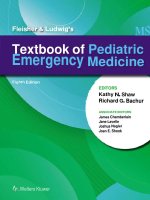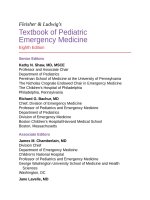Pediatric emergency medicine trisk 0314 0314
Bạn đang xem bản rút gọn của tài liệu. Xem và tải ngay bản đầy đủ của tài liệu tại đây (76.73 KB, 1 trang )
Addition of a physician or advanced care provider may increase the level of
available medical care within the ALS environment, but that impact may be
limited by the particular service’s use of protocols and offline medical direction.
CCT services can increase the medical sophistication of ALS providers by
ensuring the presence of a CCT nurse or paramedic, but these providers may be
lacking significant pediatric training, experience, expertise, and/or skills.
Pediatric CCT systems with pediatric-specialized equipment such as ventilators,
infusion pumps, and appropriately sized monitoring equipment which include
critical care providers with pediatric experience and expertise have been shown to
be associated with fewer transport-related adverse events, reduced mortality, and
better patient outcomes. These providers may include nurses, physicians,
respiratory therapists, paramedics, and advanced practice providers.
When transport services are needed, the modalities to be considered include
ground ambulance, rotor-wing (RW) (helicopter), and fixed-wing (FW) (jet or
prop plane) aircraft ( Figs. 11.4 and 11.5 ). Often, the decision is straightforward.
For example, the available transport system may be ground only, or inclement
weather may prevent air transport. Alternatively, the distance may be so great or
traffic issues significant enough that ground ambulance transport is impractical.
Several important issues should be considered when mode of transport is
discussed. The first is skilled personnel availability. If the transport mode require
or offer different personnel configurations, the mode with the most appropriate
personnel should be strongly considered. Choosing between the most readily
available, shortest out-of-hospital time, and most appropriate medical personnel
can be difficult, although they are not necessarily mutually exclusive. Ideally, a
pediatric transport service with the capability for both air and ground transport is
available, so comparative personnel issues are not the major deciding factor.
Often, the referral hospitals or physicians want to have a patient taken to the
receiving hospital as quickly as possible. They are sometimes willing to accept a
transport process with limited pediatric sophistication based solely on speed of
transport. Occasionally this may be appropriate, but caution needs to be exercised
to ensure the transport system is capable of handling issues that can occur during
the transport process. The referral physicians must be proactive in the mode of
transport decision. This includes being aware of the transport systems that are
available and evaluating those systems before requiring their use. In areas without
tertiary care pediatric transport options, local pediatric providers and receiving
physicians should be available to provide expertise to the general transport
services to help bridge the gap between the general (primarily adult) and pediatric
providers.









